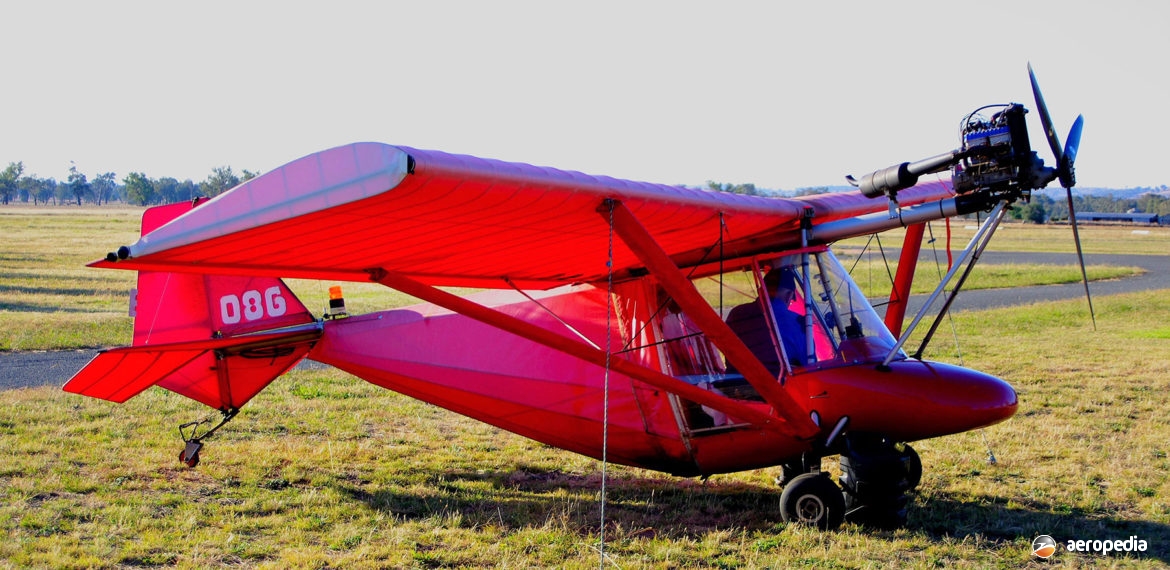Photograph:
Thruster T-300 10-0006 at Holbrook, NSW in April 2008 (David C Eyre)
Country of origin:
Australia
Description:
Two-seat light sport aircraft
Power Plant:
One 60 kw (80 hp) Jabiru 2200A four-cylinder horizontally-opposed air-cooled engine
Specifications:
- Wingspan: 9.6 m (31 ft 6 in)
- Length: 5.2 m (19 ft)
- Wing area: 15.692 m² (169.91 sq ft)
- Max speed at sea level: 166 km/h (103 mph)
- Cruising speed: 121 km/h (75 mph)
- Stalling speed at max take-off weight: 64 km/h (40 mph)
- Initial rate of climb with two occupants: 198 m/min (650 ft/min)
- Rate of climb with one occupant: 305 m/min (1,000 ft/min)
- Fuel capacity: 50 litres (11 imp gals)
- Empty weight: 197 kg (434 lb)
- Loaded weight: 450 kg (992 lb)
History:
Thruster Aircraft, an Australian firm, built light aircraft at Kirrawee, NSW, for many years, later carrying on this work of construction and development of the series at Evans Head on the NSW north coast. One of the most popular models was the Gemini, a fully certified ultralight trainer produced in two models, the single-seat Sprinter, and the two-seat Gemini. The latter had side-by-side seating in a fibreglass pod mounted below the mainplane. The remainder of the aircraft was Dacron covered.
The Gemini was built to Australian and British airworthiness standards and was usually fitted with a 43 kw (58 hp) Rotax 503 engine. Most aircraft have been registered under AUF/RAA Rules, the first registration of the RAA (10-0001) being allocated to the two-seat trainer prototype for a period whilst it was tested but eventually that registration was re-allocated to a Kestrel Kermit.
Developed from the Utility, the Thruster was the fifth light aircraft designed by Steven Cohen and first appeared in 1982. First model produced was the TST, being used on occasions for rounding up sheep and other farm work. However, some reports stated it was slow, overweight and thirsty.
In 2001 the Company built a new model known as the T-300, the first registered example of which VH-BFL (c/n 001751) was fitted with an 1800 cc Subaru engine. This aircraft was built as a test aircraft, the Company finding that the more flexible requirements of the CASA experimental category better suited the development of the design. Work then proceeded towards offering the Subaru power plant as an option for the Company’s aircraft.
Eventually rights to the design were obtained by a British company, which re-designed the aircraft to improve its marketability, this bringing about the T-600 series produced in two models, one with a tailwheel [T-600T] and the other with a tricycle undercarriage [T-600N]. Changes included an enclosed cockpit, new brakes, installation of the 48 kw (65 hp) Rotax 582 engine, electric starter and increased fuel capacity.
Further development lead to the T-600N Sprint with a 60 kw (80 hp) Jabiru 2200A engine which offered better fuel economy, improved power, a longer period between overhauls, and some aerodynamic changes to improve aesthetics. Three engines were available to builders, these normally being the Rotax 503 2V air-cooled unit; the Rotax 582 liquid-cooled two-stroke unit; and the Jabiru 2200A four-cylinder unit.

